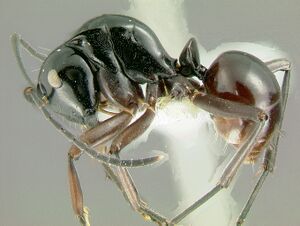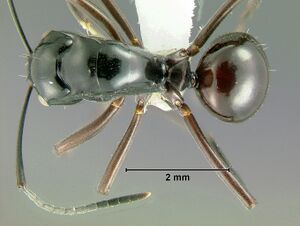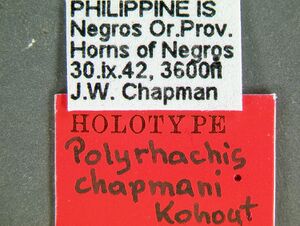Polyrhachis chapmani
| Polyrhachis chapmani | |
|---|---|

| |
| Scientific classification | |
| Kingdom: | Animalia |
| Phylum: | Arthropoda |
| Class: | Insecta |
| Order: | Hymenoptera |
| Family: | Formicidae |
| Subfamily: | Formicinae |
| Tribe: | Camponotini |
| Genus: | Polyrhachis |
| Subgenus: | Myrma |
| Species: | P. chapmani |
| Binomial name | |
| Polyrhachis chapmani Kohout, 2006 | |
Nothing is known about the biology of Polyrhachis chapmani.
Identification
A member of the Polyrhachis parabiotica species group.
Keys including this Species
Distribution
Distribution based on Regional Taxon Lists
Indo-Australian Region: Philippines (type locality).
Distribution based on AntMaps
Distribution based on AntWeb specimens
Check data from AntWeb
Countries Occupied
| Number of countries occupied by this species based on AntWiki Regional Taxon Lists. In general, fewer countries occupied indicates a narrower range, while more countries indicates a more widespread species. |

|
Estimated Abundance
| Relative abundance based on number of AntMaps records per species (this species within the purple bar). Fewer records (to the left) indicates a less abundant/encountered species while more records (to the right) indicates more abundant/encountered species. |

|
Biology
Castes
Kohout (2006) - Males and immature stages (larvae and pupae) in MCZC spirit collection.
Worker
   
| |
| . | Owned by Museum of Comparative Zoology. |
Nomenclature
The following information is derived from Barry Bolton's Online Catalogue of the Ants of the World.
- chapmani. Polyrhachis chapmani Kohout, 2006d: 157, figs 2, 5, 8 (w.q.m.) PHILIPPINES (Negros I.).
Unless otherwise noted the text for the remainder of this section is reported from the publication that includes the original description.
Description
Worker
(holotype cited first): TL c. 6.55, 6.00-7.21; HL 1.65, 1.53-1.68; HW 1.40, 1.28-1.43; CI 85, 84-87; SL 2.09. 1.93-2.15; SI 149, 144-154; PW 1.09, 1.03-1.15; MTL 2.15, 2.03-2.28 (18 rneasured), Mandibles with 5 teeth reducing in length towards base. Anterior clypeal margin arcuate, entire. In profile clypeus straight anteriorly, slightly convex posteriorly with shallow depression just in front of weakly impressed basal margin, laterally basal margin represented by only a thin line. Frontal triangle indistinct. Frontal carinae sinuate with margins at mid length moderately raised and weakly laminate, rather flat and parallel posteriorly. Central area relatively narrow anteriorly, with only barely indicated median furrow. Sides of head in front of eyes almost straight, weakly converging anteriorly towards mandibular bases; rounded behind eyes into convex, medially narrowly emarginate occipital margin. Eyes convex, in full face view exceeding lateral cephalic outline. Ocelli lacking. Pronotal dorsum weakly convex between pair of relatively long, horizontal, anteriorly directed, somewhat dorsomedially flattened spines: lateral margins of spines sharp, continuous with rather blunt lateral pronotal margins that terminate just before reaching promesonotal suture. Mesonotal dorsum with only ill-defined lateral margins; metanotal groove distinct. Propodeum immarginate laterally and posteriorly, without propodeal teeth or tubercles. Petiole scale-like, anterior face weakly convex, posterior face almost flat; dorsal margin rather acute, shallowly emarginate medially. Subpetiolar process in profile rounded anteriorly and posteriorly. Anterior face of first gastral segment lower than height of petiole, with anterodorsal face widely rounding onto dorsum of segment.
Mandibles finely, longitudinally striate with numerous piliferous pits. Body surfaces very finely reticulate, rather polished. Intensity of sculpturation marginally increasing laterally, with sides of mesosoma finely, irregularly wrinkled. Numerous shallow punctures scattered over most body surfaces.
Mandibles with a few short, semierect. yellowish-golden hairs near masticatory borders and very short, appressed hairs towards bases. Anterior clypeal margin medially usually with three longer, anteriorly directed setae and one short seta on each side towards mandibular bases. Several pairs of relatively long, erect hairs near anterior and basal clypeal margins, along frontal carinae and on vertex. A few semierect hairs on anterior face of fore coxae and several shorter, erect hairs on ventral surfaces of femora. Numerous, semierect, somewhat posteriorly directed, relatively long hairs lining posterior margins of most gastral segments, particularly abundant around gastral apex. Very short, closely appressed, golden pubescence, arising from shallow pits, scattered over all body surfaces.
Head and mesosoma black; clypeus, meso- and metapleurae diffusely blotched red or reddish-brown. Mandibles reddish-brown with outer borders and teeth black. Petiole mostly black at base. progressively becoming reddish-brown towards dorsal margin. Antennae, coxae and legs light red or reddish-brown with tarsi and proximal ends of tibiae narrowly black. Gaster red with posterior margins of segments diffusely reddish- brown.
Queen
Dimensions: TL c. 7.16-7.71; HL 1.78·1.84; HW 1.50-1.53; CI 83-86; SL 2.09-2.25; SI 130-150; PW 1.47-1.50; MTL 2.28-2.37 (4 measured). Queen very similar to worker with usual differnces indicating caste, including three ocelli and complete thoracic structure. Clypeus in profile straight anteriorly, weakly convex, posteriorly with basal margin very shallowly impressed. Eye somewhat larger and more convex than in worker. Pronotal humeri with spines marginally shorter than in worker; mesoscutum wider than long with lateral margins converging into anteriorly rounded margin; median line short, very poorly indicated: parapsides distinct, rather flat; mesoscutum in profile founding anteriorly onto flat dorsum; mesoscutellum convex, marginally elevated above dorsal plane of mesosoma; metanotal groove strongly impressed. Propodeum rounded laterally and posteriorly. Petiole subpetiolar process and anterior face of first gastral segment identical to those in worker. Mandibles finely longitudinally striate. All dorsal surfaces very finely reticulate, rather polished, but not as shiny as in worker. Pilosity similar to that in worker. with appressed pubescence more silvery and somewhat more abundant on pronotum, notably along anterior margin of mesoscutum. Black, with colour scheme virtually identical to that of worker. Except appendages and gaster distinctly darker. reddish-brown.
Type Material
Holotype worker, Philippines: Oriental Negros Prov., Cuemos de Negros Mts, 3600 ft, 30.ix.1942, J. W. Chapman. Paratvpes: 38 workers, 2 queens, 2 males, data (and nest) as for holotype; 4 workers, 2 queens. data as for holotype except 1942-43, hollow vine. Holotype and most paratype workers. 3 queens and males in Museum of Comparative Zoology; 3 workers and queen in Queensland Museum; 2 workers in each of Australian National Insect Collection and The Natural History Museum.
Three of the worker specimens of the type series, originally mounted on a single pin, are furnished with a label inscribed: "Polyrhachis (Anoplomyrma) negroensis sp.n. Chapman". In spite of this unpublished name evidently proposed by Chapman, I believe that it is more appropriate to name this new species after him.
Etymology
Named in honour of James W. Chapman, who collected many species of ants, including Polyrhachis, during his pre- and postwar residence In Dumaguete on Negros I., Philippines.

